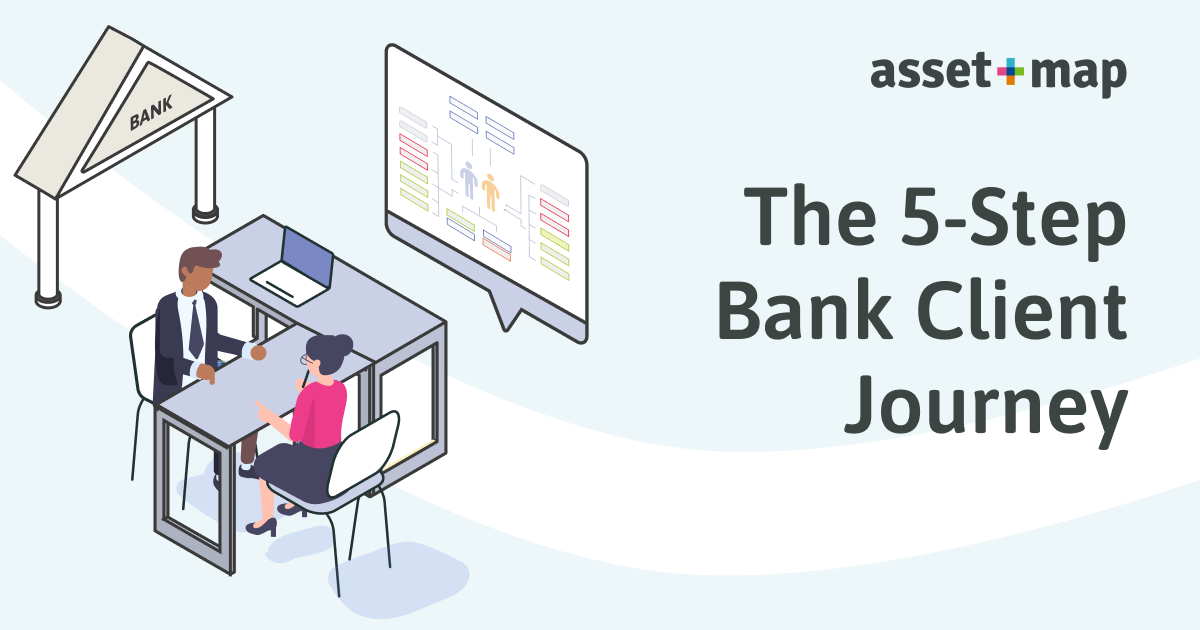The 5-Step Bank Client Journey: How Asset-Map Helps Banks Increase Client Wallet Share
By Matt LaBenz, Senior Account Manager, Emerging Enterprise Solutions
We’ve talked before about the obstacle banks face in showing clients that they’re more than just a bank. The long and short of it is that banks today offer a multitude of services, but the majority of clients view them as little more than a glorified piggy bank to keep their money safe. The rise of online banking has made it even harder, as in-person encounters result in deeper relationships and a much higher rate of intra-service referrals.
How can your bank get more clients to look to them for financial advice, or for help with their mortgage or a business loan?
By implementing Asset-Map in your bank, you could build a simple five-step process to increase your wallet share from just a checking account to a family’s entire savings and investments portfolio.
Below, I go into detail on that five-step process, which is laid out in this infographic.
1. Profile: Collect Client Data
Step one is to collect essential client information as early in the relationship as you can—ideally as part of onboarding—using our pre-built Discovery Interview. You can embed it on your website or send it via email or your social media channels.
By collecting completed financial information early in your relationship, you’re involving clients in fact-finding and removing the obstacle of unknown held-away assets.
2. Organize: Present the Asset-Map
A client’s Asset-Map serves as the perfect conversation-starter for discussing your other services. It serves as both an organizational tool to help your clients see their financial picture more clearly, and as a window to help you see where clients could use your bank’s other services.
You can discuss credit cards and show a client why they may not be in the right types of accounts, but Asset-Map also serves as a springboard for introductions to your mortgage bankers, business bankers, and your financial advisors.
That last introduction is possibly the most important one.
Most clients are at least interested in the prospect of meeting with an advisor. Even if they don’t immediately jump at the prospect of working with a mortgage or business banker, once they sign up with an advisor at your institution, referrals become much easier.
Advisors at banks rely largely on referrals from bankers. One of the biggest problems here is that bankers often either don’t know how to have that conversation, or they don’t know how to identify the right prospects. When they do send a client to an advisor, the client often isn’t a good fit.
Asset-Map solves both of those problems by helping the banker start those conversations with clients, and making it easier for your bank to show what kind of prospects should be referred to your advisors.
Once the client agrees to meet with the financial advisor, you’re ready for step three.
3. Interpret: Do You Have the Right Financial ‘Stuff’?
During this meeting, the advisor interprets the data using the Asset-Map to help provide context around the client’s financial situation.
This is the time to ask the classic advisor question—will you have enough money to reach your goals?—and help them see where they stand compared with their peers.
Again, Asset-Map provides perfect illustrations of how well client goals are funded and how they could do better.
The complexity of the client’s situation determines where the advisor takes the relationship next.
4. Implement: Let’s Fix This!
If the client’s assets call for a comprehensive planning solution, Asset-Map integrates with popular financial planning software like MoneyGuidePro, providing you with tools for an easy transition to full asset management.
If the client does not meet that threshold, then they can still maintain their assets at the bank and meet with their advisor when needed. Either way, you’ve built a solid foundation for an ongoing relationship.
Click here to download our case study: How Asset-Map Helps Valley Strong Credit Union Build Trust and Confidence With Its Clients
5. Nurture: Relationship Management
Asset-Map serves as a perfect connection between annual reviews, providing a visual reminder of where the clients were last time you met, as well as a catalyst for conversations around what has changed, what they need to do, and anything else you want to discuss.
As you can see, building a deeper, stronger relationship with bank clients is relatively easy. With the right tools, you can connect your institution’s silos and build a synergy between your teams that leads to better service for your clients, and more wallet share for your bank.

